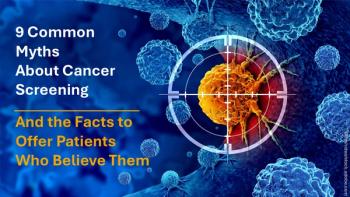
Predicting Survival in Men With Prostate Cancer
Three factors may help physicians identify older men who are unlikely to benefit from aggressive therapy, and other prostate cancer news.
Three factors-age, tumor grade, and comorbidities-may enable physicians to identify older men with prostate cancer who are unlikely to benefit from aggressive therapy.
Older patients with low- to intermediate-risk prostate cancer who have at least 3 underlying comorbidities are more likely to die of something other than their cancer, according to a large, prospective, population-based cohort study.
“Older men with multiple underlying health problems should carefully consider whether they should treat these tumors aggressively, because that treatment comes with a price,” said lead author Timothy Daskivich, MD, a Robert Wood Johnson fellow at the University of California at Los Angeles, alluding to the major adverse effects, including erectile dysfunction, urinary incontinence and bowel problems, associated with aggressive prostate cancer treatments.
In the study, the 14-year cumulative other-cause mortality rate was 57% for men with 3 comorbid conditions, more than twice that (24%) of men with no comorbidities. For men whose cancer was diagnosed at age 65 years, the subhazard ratio for other-cause mortality among those with 3 or more comorbid conditions was 2.4, twice that of men with no comorbidities (1.2). Prostate cancer–specific mortality was minimal in patients with low-risk (3%) and intermediate-risk (7%) disease but appreciable in those with high-risk disease (18%).
In many cases, “watchful waiting” or “active surveillance” is better than hitting the disease with everything in the treatment arsenal, Dr Daskivich said.
The researchers reported their
Other Prostate Cancer News
• The FDA granted
Xofigo is the second prostate cancer drug approved by the FDA in the past year that demonstrates an ability to extend the survival of men with metastatic prostate cancer. The other drug, Xtandi (enzalutamide), was approved to be taken in combination with the cancer drug docetaxel.
• A new genomic test may help distinguish aggressive prostate cancer from less threatening cancer and thereby improve risk assessment as well as aid in determining which men are suitable for active surveillance.
“The results of our study showed that the individual biological information from the Oncotype DX prostate cancer test tripled the number of patients who can more confidently consider active surveillance and avoid unnecessary treatment and its potential side effects,” said principal investigator Peter Carroll, MD, MPH, Professor and Chair of the Department of Urology at the University of California, San Francisco. The
Dr Carroll added, “The test identified a smaller number of patients (about 10%) who, despite seemingly low-risk clinical factors, had more aggressive disease and would suggest that they consider immediate treatment.”
The 17-gene Genomic Prostate Score test is now available to physicians as Oncotype DX for prostate cancer.
• To address prostate cancer early detection for the purpose of reducing prostate cancer mortality, the American Urological Association recently released the
Newsletter
Enhance your clinical practice with the Patient Care newsletter, offering the latest evidence-based guidelines, diagnostic insights, and treatment strategies for primary care physicians.




